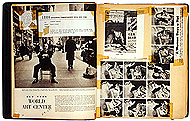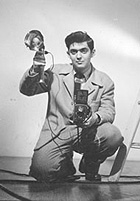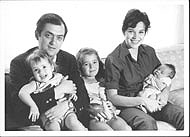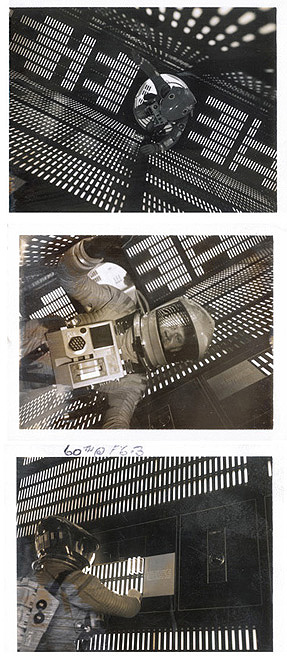[Original works from the Stanley Kubrick Estate.
Stanley Kubrick and Geoffrey Unsworth developed a system for calculating from the grey tones of b/w Polaroids the right lighting for filming
2001: A SPACE ODYSSEY.]
Update
¬ Subscribe Newsletter
Newsletter no. 10, November 2004
Dear colleagues and friends:
The 10th issue of the Stanley Kubrick newsletter also marks its first anniversary:
The first issue was published in November 2003. After a short break this summer,
publication resumed its monthly schedule in October. At that time we had asked you
for some feedback. From your answers we learned that you are highly satisfied with
the various background information on Kubrick's films and with the exhibition. We are
very happy about the positive response and will notify the winners of the give-away via email.
We would like to thank everybody who replied and we hope that you will continue to send us
suggestions and comments by way of our
¬ feedback form.
We received a wonderful compliment from an English speaking reader: "I like not only the
information, but the curiosities and the opportunity to see some of the objects from the
exhibition on 'This month's object'. […] I could not go to the exhibition in Frankfurt but
I felt like I had gone because of the Multimedia-Präsentation—it is awesome!" About Kubrick
he writes: "He is an inspiration not only to the moviemakers, but to all artists, because he
was committed to art like no one else." Beyond the question of the informational value of
the newsletter we wanted to know what you thought most important in Kubrick's work. We
received different responses to that: To some the technical aspects are most interesting
and we have always had good reason to devote much space to those. Due to Kubrick's extensive
preparatory efforts, we also paid special attention to the production processes of individual
projects. One reader mentioned the "singularity" of the films and the fact that, because there
are so few of them, we can consider them in such detail while respecting their ambiguity.
Beyond aspects related to the films themselves, like visual aesthetics and the use of music,
what seems to be fascinating to our readers is the "private" Kubrick. In this connection some
asked about the Kubrick family and their reaction to our exhibition. While we usually keep away
from personal information—because we think the work should be the focus of attention and because
Kubrick himself always kept his life from the public—we will, for once, dedicate the Short Portrait
to the Kubrick family. The keyword is "family photographs": In this issue we will look back to the
time before Kubrick entered film—to his career as photographer that he started while he was still in
school and that revealed his visual talent at an early stage. As the Berlin Kubrick exhibition
approaches, we hope to continue providing you with an interesting newsletter.
1. This month's object: the Look scrapbook

At age thirteen, Stanley Kubrick received his first camera as a gift from his father. He became
a member of the photoclub at the William Howard Taft High School. Kubrick made up his own projects
with motifs from his Bronx environment and published some of them in the school's student paper.
His first hour of success had come when on 12 April 1945 president Roosevelt died: On his way home
from school Kubrick saw the headline at a newspaper stand and took a photograph of the sad looking
newspaper vendor (Kubrick allegedly induced him to put on that sad face making this famous picture
one of his earliest clever stagings). The same day the sixteen year-old sold the image for $25 to
Look Magazine. They hired him right after high school making him the youngest staff photographer
the magazine ever had. In the 11 May 1948 issue his colleagues published a short article on him
describing him as an accomplished "veteran". Until 1951 Kubrick published numerous reports and
photo stories in Look—portraits of actors and jazz celebrities, news on exhibition openings and
glamorous events, and social documentaries. There was also a report with the title "The Prizefighter"
about the boxer Walter Cartier, which served as groundwork for his first short documentary DAY OF THE
FIGHT. His mother Gertrude started a scrapbook with clippings of his articles in
Look; in handwriting
she noted the publication date. The open page depicts the photograph with the "FDR dead"-photograph
and the report
"N.Y. World Art Center" – the man on the chair being the emigrant George Grosz.
You will be able to see the scrapbook in the exhibition area "Jazz – Chess – Photo".
2. Portrait: Kubrick's family

Kubrick's well-to-do-parents always supported their son's talents while he was raised in the Bronx.
His father Jaques L. Kubrick, a medical doctor, encouraged Stanley to take up photography and
introduced him to literature and chess – remaining important constants in Kubrick's life. In 1934
Kubrick's sister Barbara was born and Stanley started school. He showed little interest in school,
in spite of—or possibly, because of—his extraordinary intelligence and he finished in 1945 with a
hardly remarkable report card. At this time he already worked as a professional photographer. In
the 1946 Look story "What's your idea of a good time?" there is one photograph showing Toba Metz,
his longtime girlfriend in high school whom he married in 1948 and moved to Greenwich Village with.
She supported him as dialogue director and scriptgirl in his first feature film FEAR AND DESIRE (1951-53).
His second wife was the dancer Ruth Sobotka. She had emigrated in 1938 from Vienna and its was she
allegedly who brought to his attention Schnitzler's Rhapsody. A Dream Novel. She also introduced
him to the New York avant-garde art circles that she frequented. In 1947 Ruth had appeared in Hans
Richter's surrealist film DREAMS THAT MONEY CAN BUY in an episode conceived by Man Ray. In Kubrick's
second film KILLER'S KISS (1955) she has the role of a dancer.

His one true love to whom he stayed married for the rest of his life he met in 1957 at the Munich
set of PATHS OF GLORY. The actress Susanne Christian, née Christiane Susanne Harlan, played the
German prisoner in the final sequence. Afterwards she accompanied him to Hollywood for the filming
of SPARTACUS taking her daughter Katharina (her child from her marriage to German actor Werner Bruhns)
whom Kubrick would always treat as his own. Their common children, Anya and Vivian, were born
in 1958 and 1960 respectively. After stops in London for the filming of LOLITA and a stay in New
York where Christiane Kubrick pursued her true passion and studied painting, the family finally
settled in England. Kubricks dauhters all later became artists and variously collaborated on his
films. Anya Kubrick runs her own opera company. Katharina Kubrick became a painter like her mother
and worked in art departments of several successful British film productions. Four of her paintings
can be seen in EYES WIDE SHUT. Vivian Kubrick, at age five, appears in 2001: A SPACE ODYSSEY as the
daughter of Dr. Floyd. As grownup she made the documentary MAKING OF THE SHINING and composed (under
the pseudonym Abigail Mead) the music for FULL METAL JACKET.
In 1969 Kubrick started to work with Christiane's brother Jan Harlan who initially did research for
the Napoleon project and subsequently became Kubrick's closest assistant and his executive producer.
In his documentary STANLEY KUBRICK. A LIFE IN PICTURES (2001), a very rich and personal portrait of
his brother-in-law who had died in 1999, Harlan depicts Kubrick as a film director obsessed with his
work, but also as a loving family man. In this the documentary runs contrary to the clichés repeated
time and again by the press of the unapproachable and women hating loner.
The willing collaboration and the friendly openness of both Christiane Kubrick and Jan Harlan made
possible the thorough sorting since 2002 of the extensive archives by the Deutsches Filmmuseum and
eventually the presentation of parts of it in the exhibition. The selection of the material was made
in close cooperation. According to Kubrick's family they are very happy with the exhibition design.
3. Kubrick exhibition in Berlin: cooperations
The exhibition at the Martin-Gropius-Bau in Berlin (20 January through 11 April 2005) is supported
by the Hauptstadtkulturfonds and by the Kulturstiftung des Bundes. Stanley Kubrick's films will be
shown at the 55th International Film Festival Berlin (10 through 20 February 2005), additional
shows will take place at the Zeughaus-Kino of the Deutsches Historisches Museum (23 February through 6 March 2005).
The Berlin Film Festival will devote its retrospective with the title “Settings –Locations–Scenes” to
the art of production design. The film series contains 45 international films from the last 65 years.
A special focus will be on Kubrick's groundbreaking films including 2001: A SPACE ODYSSEY, DR. STRANGELOVE OR:
HOW I LEARNED TO STOP WORRYING AND LOVE THE BOMB, or THE SHINING. The Filmmuseum Berlin - Deutsche
Kinemathek presents the exhibition “Moving Spaces” from 10 February through 19 June 2005. Due to the
cooperation with the Deutsches
Filmmuseum Frankfurt am Main this exhibition will also feature objects related to Kubrick's films.
For more information:
¬ www.berlinale.de
4. Annotation
As a response to our questionnaire we received the suggestion to send out the present texts in
full length and with the illustrations as HTML-mail. However, we have decided to continue using
the abbreviated Email version in order to provide a better overview. For all those interested we
still provide the full-length version on our website.
Several users mentioned the new features and specials on our website, like the
¬ panorama shots from
the exhibition or the
¬ diary of Matthew Modine. This month we can present you the
¬ extended filmography
with images and compact texts on contents and background information on the film productions.
¬ print


 At age thirteen, Stanley Kubrick received his first camera as a gift from his father. He became
a member of the photoclub at the William Howard Taft High School. Kubrick made up his own projects
with motifs from his Bronx environment and published some of them in the school's student paper.
His first hour of success had come when on 12 April 1945 president Roosevelt died: On his way home
from school Kubrick saw the headline at a newspaper stand and took a photograph of the sad looking
newspaper vendor (Kubrick allegedly induced him to put on that sad face making this famous picture
one of his earliest clever stagings). The same day the sixteen year-old sold the image for $25 to
Look Magazine. They hired him right after high school making him the youngest staff photographer
the magazine ever had. In the 11 May 1948 issue his colleagues published a short article on him
describing him as an accomplished "veteran". Until 1951 Kubrick published numerous reports and
photo stories in Look—portraits of actors and jazz celebrities, news on exhibition openings and
glamorous events, and social documentaries. There was also a report with the title "The Prizefighter"
about the boxer Walter Cartier, which served as groundwork for his first short documentary DAY OF THE
FIGHT. His mother Gertrude started a scrapbook with clippings of his articles in Look; in handwriting
she noted the publication date. The open page depicts the photograph with the "FDR dead"-photograph
and the report
"N.Y. World Art Center" – the man on the chair being the emigrant George Grosz.
You will be able to see the scrapbook in the exhibition area "Jazz – Chess – Photo".
At age thirteen, Stanley Kubrick received his first camera as a gift from his father. He became
a member of the photoclub at the William Howard Taft High School. Kubrick made up his own projects
with motifs from his Bronx environment and published some of them in the school's student paper.
His first hour of success had come when on 12 April 1945 president Roosevelt died: On his way home
from school Kubrick saw the headline at a newspaper stand and took a photograph of the sad looking
newspaper vendor (Kubrick allegedly induced him to put on that sad face making this famous picture
one of his earliest clever stagings). The same day the sixteen year-old sold the image for $25 to
Look Magazine. They hired him right after high school making him the youngest staff photographer
the magazine ever had. In the 11 May 1948 issue his colleagues published a short article on him
describing him as an accomplished "veteran". Until 1951 Kubrick published numerous reports and
photo stories in Look—portraits of actors and jazz celebrities, news on exhibition openings and
glamorous events, and social documentaries. There was also a report with the title "The Prizefighter"
about the boxer Walter Cartier, which served as groundwork for his first short documentary DAY OF THE
FIGHT. His mother Gertrude started a scrapbook with clippings of his articles in Look; in handwriting
she noted the publication date. The open page depicts the photograph with the "FDR dead"-photograph
and the report
"N.Y. World Art Center" – the man on the chair being the emigrant George Grosz.
You will be able to see the scrapbook in the exhibition area "Jazz – Chess – Photo".  Kubrick's well-to-do-parents always supported their son's talents while he was raised in the Bronx.
His father Jaques L. Kubrick, a medical doctor, encouraged Stanley to take up photography and
introduced him to literature and chess – remaining important constants in Kubrick's life. In 1934
Kubrick's sister Barbara was born and Stanley started school. He showed little interest in school,
in spite of—or possibly, because of—his extraordinary intelligence and he finished in 1945 with a
hardly remarkable report card. At this time he already worked as a professional photographer. In
the 1946 Look story "What's your idea of a good time?" there is one photograph showing Toba Metz,
his longtime girlfriend in high school whom he married in 1948 and moved to Greenwich Village with.
She supported him as dialogue director and scriptgirl in his first feature film FEAR AND DESIRE (1951-53).
His second wife was the dancer Ruth Sobotka. She had emigrated in 1938 from Vienna and its was she
allegedly who brought to his attention Schnitzler's Rhapsody. A Dream Novel. She also introduced
him to the New York avant-garde art circles that she frequented. In 1947 Ruth had appeared in Hans
Richter's surrealist film DREAMS THAT MONEY CAN BUY in an episode conceived by Man Ray. In Kubrick's
second film KILLER'S KISS (1955) she has the role of a dancer.
Kubrick's well-to-do-parents always supported their son's talents while he was raised in the Bronx.
His father Jaques L. Kubrick, a medical doctor, encouraged Stanley to take up photography and
introduced him to literature and chess – remaining important constants in Kubrick's life. In 1934
Kubrick's sister Barbara was born and Stanley started school. He showed little interest in school,
in spite of—or possibly, because of—his extraordinary intelligence and he finished in 1945 with a
hardly remarkable report card. At this time he already worked as a professional photographer. In
the 1946 Look story "What's your idea of a good time?" there is one photograph showing Toba Metz,
his longtime girlfriend in high school whom he married in 1948 and moved to Greenwich Village with.
She supported him as dialogue director and scriptgirl in his first feature film FEAR AND DESIRE (1951-53).
His second wife was the dancer Ruth Sobotka. She had emigrated in 1938 from Vienna and its was she
allegedly who brought to his attention Schnitzler's Rhapsody. A Dream Novel. She also introduced
him to the New York avant-garde art circles that she frequented. In 1947 Ruth had appeared in Hans
Richter's surrealist film DREAMS THAT MONEY CAN BUY in an episode conceived by Man Ray. In Kubrick's
second film KILLER'S KISS (1955) she has the role of a dancer.  His one true love to whom he stayed married for the rest of his life he met in 1957 at the Munich
set of PATHS OF GLORY. The actress Susanne Christian, née Christiane Susanne Harlan, played the
German prisoner in the final sequence. Afterwards she accompanied him to Hollywood for the filming
of SPARTACUS taking her daughter Katharina (her child from her marriage to German actor Werner Bruhns)
whom Kubrick would always treat as his own. Their common children, Anya and Vivian, were born
in 1958 and 1960 respectively. After stops in London for the filming of LOLITA and a stay in New
York where Christiane Kubrick pursued her true passion and studied painting, the family finally
settled in England. Kubricks dauhters all later became artists and variously collaborated on his
films. Anya Kubrick runs her own opera company. Katharina Kubrick became a painter like her mother
and worked in art departments of several successful British film productions. Four of her paintings
can be seen in EYES WIDE SHUT. Vivian Kubrick, at age five, appears in 2001: A SPACE ODYSSEY as the
daughter of Dr. Floyd. As grownup she made the documentary MAKING OF THE SHINING and composed (under
the pseudonym Abigail Mead) the music for FULL METAL JACKET.
His one true love to whom he stayed married for the rest of his life he met in 1957 at the Munich
set of PATHS OF GLORY. The actress Susanne Christian, née Christiane Susanne Harlan, played the
German prisoner in the final sequence. Afterwards she accompanied him to Hollywood for the filming
of SPARTACUS taking her daughter Katharina (her child from her marriage to German actor Werner Bruhns)
whom Kubrick would always treat as his own. Their common children, Anya and Vivian, were born
in 1958 and 1960 respectively. After stops in London for the filming of LOLITA and a stay in New
York where Christiane Kubrick pursued her true passion and studied painting, the family finally
settled in England. Kubricks dauhters all later became artists and variously collaborated on his
films. Anya Kubrick runs her own opera company. Katharina Kubrick became a painter like her mother
and worked in art departments of several successful British film productions. Four of her paintings
can be seen in EYES WIDE SHUT. Vivian Kubrick, at age five, appears in 2001: A SPACE ODYSSEY as the
daughter of Dr. Floyd. As grownup she made the documentary MAKING OF THE SHINING and composed (under
the pseudonym Abigail Mead) the music for FULL METAL JACKET.